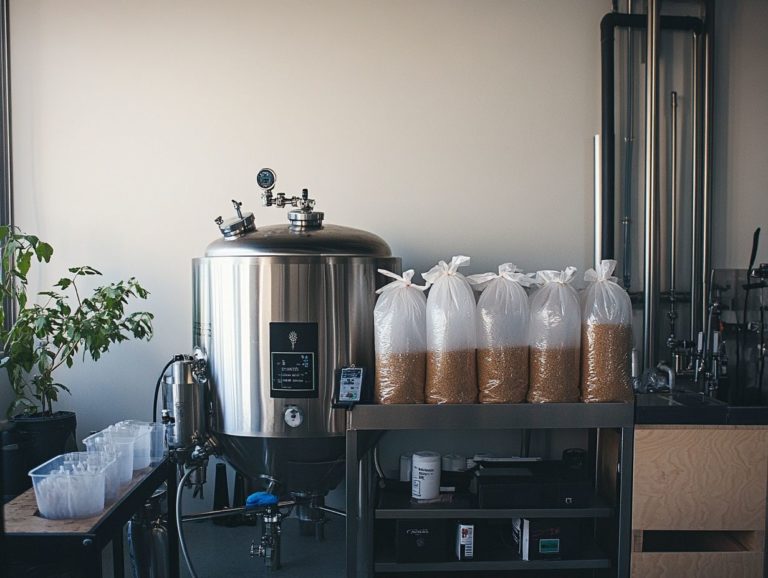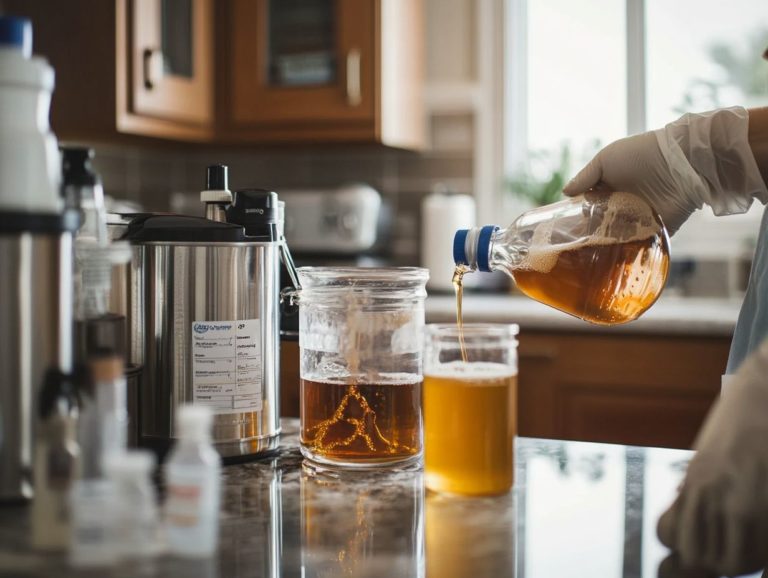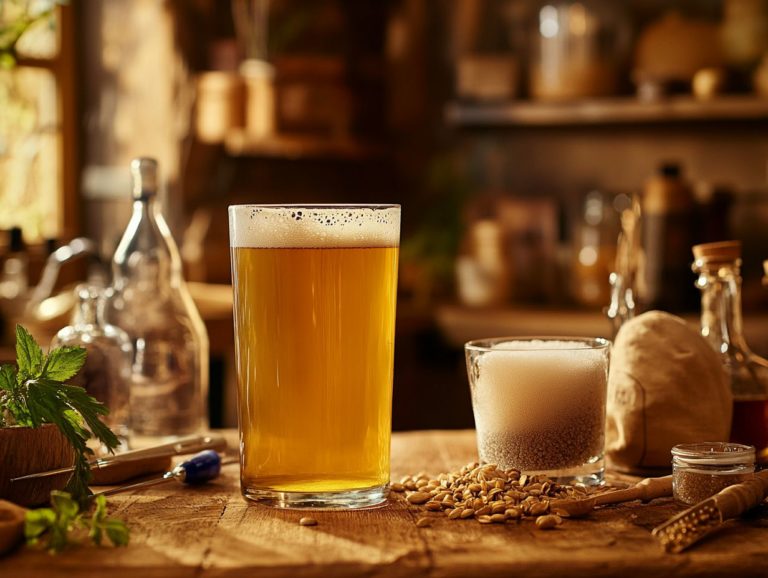Identifying and Fixing Beer Volatile Compounds
Beer transcends mere refreshment; it is a complex symphony of flavors and aromas intricately shaped by volatile organic compounds. These substances are pivotal in defining the unique characteristics of your favorite brews. Grasping what these compounds are and their significance is vital for any dedicated beer enthusiast or brewer.
Incorporating machine learning models into beer production can further enhance our understanding and control over these compounds, leading to consistent beer quality. This article delves into the nature of beer volatile compounds, explores methods for their identification, and offers practical tips for managing them to elevate your brewing experience. The collaboration between brewers and food science experts can lead to innovative approaches in handling these compounds.
Contents
- Key Takeaways:
- What are Beer Volatile Compounds?
- Why are Beer Volatile Compounds Important?
- What Role Do They Play in Beer Flavor and Aroma?
- How are Beer Volatile Compounds Identified?
- What are the Key Compounds to Look for?
- What Causes Beer Volatile Compounds?
- How Can Beer Volatile Compounds Be Controlled?
- What are the Common Off-Flavors Caused by Volatile Compounds?
- What are Some Tips for Avoiding Volatile Compounds in Beer?
- How Can Proper Sanitation and Cleaning Help?
- What are Some Best Practices for Handling Ingredients?
- How Can Proper Fermentation Techniques Help Control Volatile Compounds?
- Frequently Asked Questions
- What are beer volatile compounds?
- How can I identify beer volatile compounds?
- What are some common beer volatile compounds and their effects?
- How do I fix off-flavors caused by volatile compounds?
- Can I prevent the formation of unwanted volatile compounds in beer?
- Are beer volatile compounds harmful to consume?
Key Takeaways:

- Understanding the role of volatile compounds in beer flavor and aroma is essential for producing high-quality beer.
- Proper sanitation, ingredient handling, and fermentation techniques can help control and reduce the presence of off-flavors caused by volatile compounds.
- Analytical techniques like gas chromatography and mass spectrometry are used to identify and monitor key volatile compounds in beer for quality control. Utilizing advanced instruments like the PerkinElmer TurboMatrix and Clarus SQ 8 GC/MS can significantly enhance the accuracy of these analyses.
What are Beer Volatile Compounds?
Beer volatile compounds, commonly known as volatile organic compounds (VOCs), play a crucial role in shaping your overall sensory experience of beer, affecting its smell and taste. These compounds emerge during various stages of the brewing process and contribute to the distinct characteristics that define different beer styles.
By employing advanced sensory analysis techniques, brewers can better understand these compounds’ impact on sensory attributes. To truly appreciate these compounds, you need to dive into the brewing ingredients and understand how they interact throughout fermentation and maturation. This reveals a complex web of chemical properties underpinning beer quality.
The use of statistical methods and data analysis in this context can provide deeper insights into these interactions. Identifying and quantifying these compounds is vital for brewers like you who want to optimize flavor perception and enhance the enjoyment of your creations among consumers.
Why are Beer Volatile Compounds Important?
Grasping the significance of beer volatile compounds is essential for both brewers and consumers, as these compounds play a pivotal role in determining beer quality and enriching the tasting experience. Sensory properties such as aroma, flavor, and mouthfeel are all influenced by these compounds, thereby affecting overall consumer appreciation and reviews on platforms like RateBeer.
The specific flavor-active chemicals present in the brew can elevate flavor perception, shaping consumer reviews and preferences. In the realm of a trained tasting panel, these sensory characteristics emerge as critical indicators influencing the success of various beer styles in a competitive marketplace. The use of quantitative descriptive analysis in sensory evaluation can provide a more objective assessment of these characteristics.
Have you ever wondered how certain beers have that unforgettable aroma? Unlock the secrets of exceptional beer quality today!
What Role Do They Play in Beer Flavor and Aroma?
Beer s flavor compounds are the unsung heroes that shape the flavor and aroma of your favorite brew, making them absolutely essential in the brewing process. These compounds think esters and acids stem from the fermentation of sugars, and they wield significant influence over your sensory experience. Brewers can optimize brewing parameters by understanding how flavor compounds affect sensory perception.
The intricate dance between various brewing ingredients and the resulting flavor-active chemicals crafts the unique profiles of different beer styles. Exploring food engineering applications can further enhance these profiles, ensuring a memorable tasting journey.
Among these flavor compounds, esters like ethyl acetate stand out with their delightful fruity notes, while higher alcohols such as fusel oils add a layer of depth and complexity that you can truly appreciate. For instance, by employing specific yeast strains, brewers can enhance the production of these esters, creating unique flavor profiles that vary dramatically between a refreshing wheat beer and a rich stout. The alcohol content also significantly influences the flavor perception of these beers.
Hops introduce another dimension, with terpenes that evoke citrus, floral, or herbal nuances, further enriching the aroma.
This intricate interplay between ingredients not only defines the distinct characteristics of each beer but also encourages brewers like you to explore innovative combinations. You can unlock incredible flavors for enthusiasts to savor.
How are Beer Volatile Compounds Identified?
Identifying the volatile compounds in beer requires advanced analytical techniques that enable detailed chemical analyses of flavor-active chemicals. Utilizing methods like gas chromatography-mass spectrometry (GC-MS), a technique that separates and analyzes chemical compounds in beer, you can effectively separate and quantify these volatile organic compounds.
This process allows for a comprehensive understanding of their presence across different beer styles. Such methods have become the gold standard in beverage quality evaluation, giving brewers the power to ensure consistency and meet consumer expectations through precise flavor prediction.
What Analytical Techniques are Used?
You ll discover a range of innovative analytical techniques designed to identify and quantify volatile organic compounds in beer, with automated analysis leading the charge in contemporary research. One standout method is the headspace trap, which, when paired with advanced systems like the PerkinElmer TurboMatrix, facilitates the efficient extraction and analysis of volatile compounds from beer samples. This cutting-edge technology empowers brewers to glean valuable insights into the chemical properties of their products, ultimately enhancing flavor consistency.
Along with headspace analysis, gas chromatography coupled with mass spectrometry (GC-MS) stands out as another formidable technique for identifying volatile compounds. This approach effectively separates complex mixtures, delivering both qualitative and quantitative insights into the compounds present in beer. Applying machine learning approaches to the data obtained from these analyses can further refine flavor prediction models, ensuring more consistent and desirable outcomes.
By leveraging automated systems such as the PerkinElmer Flexar, you can streamline the sample processing workflow, significantly cutting down on analysis time while maintaining accuracy. These sophisticated methods not only deepen your understanding of beer s aroma and flavor profile but also play an essential role in quality control and regulatory compliance, ensuring that your brews consistently meet consumer expectations.
What are the Key Compounds to Look for?

When you analyze the important flavor components in beer, several key players demand your attention due to their profound influence on flavor and aroma. Esters and acids are among the most crucial flavor-active compounds. Esters bring fruity notes to the table, and acids add a delightful sourness.
By identifying these compounds, you gain a deeper understanding of the beer’s characteristics, empowering you to optimize brewing parameters and enhance overall flavor perception. Non-alcoholic beers also benefit from this analysis. Understanding these compounds helps in crafting beverages that deliver rich sensory attributes without alcohol.
These volatile compounds emerge during various stages of the brewing process, shaped by yeast strains, fermentation conditions, and ingredient choices. For example, esters like ethyl acetate and isoamyl acetate contribute enticing aromas reminiscent of bananas or pears. Organic acids, such as lactic and acetic acid, introduce layers of tartness and complexity.
Sensory analysis of these compounds provides valuable insights into their impact on beer characteristics. Understanding the perfect blend of these elements not only enriches your experience as a drinker but also enables brewers to craft unique styles that cater to specific palates.
By mastering the interplay of these essential compounds, you can elevate your brewing creations and offer distinct flavor nuances that resonate with beer enthusiasts. Make each sip a memorable journey.
What Causes Beer Volatile Compounds?
The formation of important flavor components in beer stems from a variety of factors intrinsic to the brewing process, highlighting a remarkable chemical diversity. Each stage of brewing ranging from fermentation to maturation engages in intricate interactions among the ingredients, including yeast, malt, hops, and water. This results in a diverse array of volatile organic compounds. You need advanced chemical analyses to accurately profile these compounds.
Understanding the origins of these compounds is essential for you as a brewer aiming to elevate the flavor and aroma of your creations.
What are the Sources of Volatile Compounds in Beer?
The sources of important flavor components in beer can be traced back to the various brewing ingredients and the fermentation process. Hops, malt, and yeast are your primary allies in this endeavor, releasing a fascinating array of volatile organic compounds through biochemical reactions during fermentation.
Each of these ingredients imparts distinct flavors and aromas, collectively shaping the final profile of your beer. Hops deserve special recognition for their essential oils. These oils not only balance the sweetness of malt with bitterness but also introduce a delightful medley of aromatic compounds, ranging from floral to citrus and even pine notes.
Meanwhile, malt provides the sugars that yeast eagerly ferments, resulting in alcohol and carbon dioxide, while adding rich flavors like caramel and chocolate, depending on the type of malt used. Yeast plays a crucial role in this symphony, fermenting those sugars and creating esters and phenols that enhance the complexity of your brew with fruity and spicy undertones.
The dynamic interactions among these ingredients during fermentation are essential in crafting the aromatic tapestry that defines each unique beer, making your brewing journey all the more rewarding. Explore food science principles to enhance your understanding of these interactions, ensuring better control over the sensory attributes of the final product.
Dive into the world of flavor compounds now and transform your brewing experience!
How Do Brewing Processes Affect Volatile Compounds?
The brewing process you choose profoundly impacts the production of volatile compounds, which in turn shapes the overall flavor and aroma of your beer. Various brewing parameters, such as fermentation techniques, temperature control, and ingredient selection, are crucial in crafting the volatile profile. By understanding these factors, you can predict flavor outcomes and fine-tune your processes to achieve the tasting attributes you desire.
Delving into the nuances of different fermentation methods, like wild fermentation versus controlled yeast strains, highlights their significant influence on the development of volatile compounds. For instance, wild fermentation can introduce a variety of esters and phenols that aren t typically seen in traditional brewing, often leading to truly unique flavor profiles. Additionally, variations in temperature during fermentation can modify yeast activity, thereby impacting the generation of aromatic compounds.
By analyzing these relationships, you can skillfully manipulate your brewing processes to nurture specific sensory experiences, elevating the overall enjoyment of your final product.
How Can Beer Volatile Compounds Be Controlled?
Controlling volatile compounds in beer is crucial for you as a brewer who seeks to maintain consistent flavor profiles and elevate beverage quality. A variety of techniques can be employed to manage the production and release of these volatile organic compounds throughout your brewing process.
By gaining a deep understanding of the factors that influence these compounds, you can implement effective strategies to control their presence and optimize the flavor outcomes of your creations.
How Can Volatile Compounds Be Reduced or Removed?
You have a variety of techniques at your disposal to reduce or remove volatile compounds from beer, ensuring a high-quality product that meets the expectations of discerning consumers. Methods like degassing and specific filtration techniques minimize unwanted flavors. They also preserve the beer’s integrity.
Another approach involves utilizing activated carbon, which captures unpleasant compounds, particularly those linked to off-flavors from fermentation byproducts. Bioreactor and continuous fermentation processes help manage volatile acids during brewing.
These methods not only enhance flavor profiles but also contribute significantly to the final sensory experience.
By employing such targeted techniques, you can eliminate potential spoilage microorganisms and craft a product that offers a balanced and enjoyable taste, ultimately satisfying the evolving palate of beer enthusiasts.
How Can the Brewing Process Be Adjusted to Control Volatile Compounds?

Adjusting your brewing process is an essential strategy for controlling volatile compounds and achieving the flavor outcomes you desire in beer production. By modifying various parameters like fermentation temperature, time, and ingredient proportions you can significantly influence the development of volatile organic compounds. These adjustments grant you precise control over flavor profiles, enhancing the overall experience for your consumers.
Selecting specific yeast strains that produce favorable esters and phenols can further refine your flavor profiles. Managing oxygen exposure at different stages of brewing is equally critical, as it can either enhance or diminish the desired volatile aromas. Understanding the science behind these compounds empowers you to create distinctive, appealing beer varieties that captivate your consumers!
For instance, lowering fermentation temperatures can help highlight those subtle fruity notes, while higher temperatures might yield spicier characteristics, ultimately leading to a more complex flavor palette.
What are the Common Off-Flavors Caused by Volatile Compounds?
Common off-flavors in beer can often be traced back to undesirable volatile compounds that significantly alter flavor perception and the overall characteristics of the brew. These off-flavors may feature hints of diacetyl or phenolic compounds. They can detract from the intended sensory experience and negatively impact consumer appreciation.
For you as a brewer, understanding the sources and nature of these off-flavors is crucial in your pursuit of creating high-quality products that truly satisfy and delight your audience.
What Do These Off-Flavors Smell and Taste Like?
Off-flavors in beer present distinct sensory attributes that can significantly impact your overall experience as a consumer. Take diacetyl, for example; it s often described as having a buttery aroma.
Other off-flavors might remind you of phenolic compounds, with clove or medicinal notes creeping in. Being able to identify these off-flavors through your own sensory perception is crucial for brewers aiming to mitigate their effects on both aroma and taste.
Consider off-flavors like acetaldehyde, which can give off a green apple flavor. There s also oxidation, which introduces cardboard-like or sherry notes. These unwelcome flavors can drastically alter a beer s intended profile, detracting from your sensory experience and potentially misleading you about the product’s quality.
This highlights the importance of systematic sensory analysis. By utilizing trained panels or gathering consumer feedback, brewers can pinpoint problematic flavors early in the brewing process. Through comprehensive sensory evaluation, they can ensure their creations meet high standards, ultimately elevating your enjoyment and satisfaction as a discerning beer lover.
How Can They be Identified and Fixed?
Identifying and fixing off-flavors in beer demands your meticulous attention. This involves both sensory analysis and a comprehensive understanding of the brewing process.
You can employ trained tasting panels to detect those pesky off-flavors. Then, make necessary adjustments in your brewing parameters to tackle the root causes. Implementing corrective measures based on this identification process is crucial for restoring the desired flavor profiles.
To successfully pinpoint these undesirable tastes, many brewers like you rely on an effective blend of sensory evaluation techniques and chemical analysis. Sensory analysis often involves the expertise of trained panels that can discern subtle variations in flavor, aroma, and mouthfeel that might escape an untrained palate.
These panels are invaluable, offering insights that enable you to refine your recipes. Corrective actions could range from altering ingredient ratios to enhancing sanitation practices and adjusting fermentation conditions.
By systematically addressing the sources of off-flavors, you not only remedy current batches but also prevent future occurrences. This ensures a consistently delightful product for your consumers.
What are Some Tips for Avoiding Volatile Compounds in Beer?
Avoiding undesirable volatile compounds in beer production is crucial for crafting high-quality beverages. You can implement several practical tips to achieve this.
Prioritizing proper sanitation and cleaning practices is essential. These play a critical role in preventing contamination that could introduce off-flavors. Handling brewing ingredients with care can also significantly reduce the risk of unwanted volatile compounds making their way into your brew.
By embracing best practices throughout the brewing process, you can maintain the integrity of flavors and elevate the overall quality of your beer.
How Can Proper Sanitation and Cleaning Help?
Proper sanitation and cleaning are not just afterthoughts in beer production; they are essential practices that significantly mitigate the risk of contamination and the introduction of unwanted volatile compounds.
By maintaining a sterile environment, you ensure that no pesky microorganisms interfere with the flavor profile of your beer, thereby preserving its intended qualities. Consistent cleaning protocols are essential for crafting high-quality beverages that align with consumer preferences.
The consequences of inadequate cleaning go beyond immediate flavor discrepancies; they can also inflict lasting reputational damage on breweries.
Implementing comprehensive cleaning regimes, including the use of specialized detergents and sanitizers, is crucial for equipment such as fermenters and kegs. This meticulous attention to detail not only reduces the risk of spoilage but also elevates the overall mouthfeel and aroma of your final product.
Breweries that prioritize these practices often discover that their customers notice the difference, cultivating brand loyalty and encouraging repeat business.
What are Some Best Practices for Handling Ingredients?

Best practices for managing your brewing ingredients are essential for minimizing volatile compounds that could compromise the quality of your beer.
By ensuring the freshness of key ingredients like hops and malt, along with adhering to proper storage protocols, you can significantly enhance the development of flavor attributes.
To maintain that vital freshness, store your malt in a cool, dry space, away from light and humidity, both of which can lead to degradation.
Hops should be vacuum-sealed and frozen if you’re not using them right away; exposure to air can quickly strip away the aroma and flavor oils that are crucial for achieving a balanced brew.
Regular inventory checks will help you use older ingredients first, ensuring that freshness remains a top priority.
By implementing these practices, you can effectively reduce the risk of introducing unwanted volatile compounds and safeguard the integrity and taste of your final product.
How Can Proper Fermentation Techniques Help Control Volatile Compounds?
Proper fermentation techniques are crucial for you in controlling volatile compounds during beer production, allowing you to achieve a balanced and desirable flavor profile.
Factors such as fermentation temperature, yeast strain selection, and fermentation duration all play significant roles in influencing the production of volatile organic compounds.
By adopting meticulous fermentation practices, you can minimize the risk of off-flavors and elevate the overall quality of your beer.
Maintaining optimal fermentation temperatures is essential; any variations can lead to the production of unwanted esters and phenolic compounds that may distort your intended flavor profile.
The yeast strain you choose will significantly impact the types and levels of volatile compounds generated, as different strains are celebrated for their unique flavor contributions.
Closely monitoring fermentation duration benefits the brewing process, as allowing the yeast enough time to complete its active phase can result in more thorough attenuation and improved flavor harmony.
Implementing these effective practices not only enhances the sensory attributes of your beer but also contributes to the overall stability and shelf life of your final product.
Frequently Asked Questions
Here are some common questions about beer volatile compounds and their impact on brewing.
What are beer volatile compounds?
Beer volatile compounds are substances present in beer that can easily vaporize and contribute to its flavor, aroma, and overall quality. These compounds are responsible for the distinct characteristics and complexity of different types of beer.
How can I identify beer volatile compounds?
There are various techniques used to identify beer volatile compounds, such as gas chromatography-mass spectrometry (GC-MS) and solid-phase microextraction (SPME). These methods allow for the separation and analysis of individual compounds present in beer samples.
Start experimenting with these practices in your brews today for outstanding results!
Have you ever wondered what gives your favorite beer its unique taste? In this article, we explore common compounds that evaporate and contribute to beer’s aroma and flavor, as well as how to manage them.
What are some common beer volatile compounds and their effects?
Some common beer compounds that evaporate include esters, aldehydes, and sulfur compounds. Esters contribute to fruity and floral aromas.
Aldehydes can cause off-flavors, such as a taste of paper or cardboard. Sulfur compounds can give beer a distinct “skunky” odor.
How do I fix off-flavors caused by volatile compounds?
If your beer has an off-flavor, the first step is to identify the specific compounds responsible. After identifying the compounds, you can adjust the brewing process.
Using specific ingredients can also minimize or eliminate these off-flavors.
Can I prevent the formation of unwanted volatile compounds in beer?
Yes, you can use methods during brewing to minimize unwanted compounds. Discover how you can brew the perfect beer!
Controlling fermentation temperature, using high-quality ingredients, and proper sanitation are effective ways to prevent the formation of off-flavors.
Are beer volatile compounds harmful to consume?
No, beer volatile compounds are not harmful to consume in reasonable amounts. In fact, these compounds contribute to the unique flavors and aromas of beer.
However, excessive amounts of certain compounds, such as aldehydes and sulfur compounds, can result in unpleasant flavors and should be avoided.






